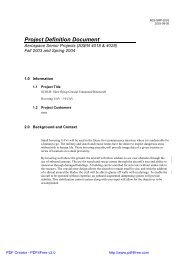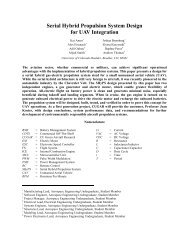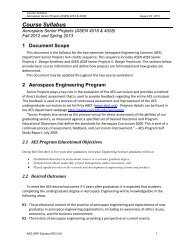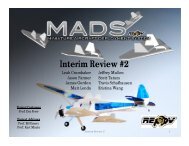PFR - Aerospace Engineering Sciences Senior Design Projects ...
PFR - Aerospace Engineering Sciences Senior Design Projects ...
PFR - Aerospace Engineering Sciences Senior Design Projects ...
Create successful ePaper yourself
Turn your PDF publications into a flip-book with our unique Google optimized e-Paper software.
Project Final Report – CUDBF April 30 th , 2009<br />
ASEN 4028: <strong>Aerospace</strong> <strong>Senior</strong> <strong>Projects</strong><br />
6.0 Subsystem <strong>Design</strong>-To Specifications<br />
Author: Jarryd Allison<br />
Co-Author: Brett Miller<br />
6.1 Aerodynamics <strong>Design</strong>-To Specifications<br />
Requirements for the aerodynamics subsystem were derived from customer requirements as well<br />
as from the mission goals. The customer required that the aircraft take off in no more than 100 ft<br />
and fly at conditions in a 5000 ft density altitude. Additionally, it was required that the minimum<br />
wing span shall be no less than 5 ft and the airplane is required to be stable in both the<br />
asymmetric and symmetric load cases.<br />
Since the overall goal of the team is to win the competition, performance requirements were<br />
derived from past competition winners. The aircraft was required to cruise at 100 ft/sec, stall at<br />
40 ft/sec, and perform a 2 g maneuver at 80 ft/sec. Heuristic data is valid because performance<br />
specifications such as cruise speed, and stall speed have not varied over the past years’<br />
competition winners regardless of mission or overall aircraft configuration.<br />
6.2 Missions <strong>Design</strong>-To Specifications<br />
The design-to specifications for the Missions subsystem can be broken into three separate<br />
elements: the wing mounted stores, the centerline store, and the aircraft container. Each of these<br />
is vital to the mission of the aircraft and its performance at competition.<br />
The design process includes an analysis of the loads acting on the stores, consideration of<br />
multiple design alternatives, testing of those alternatives, an educated selection based on the test<br />
results, and finally a successful implementation of the design choice.<br />
6.2.1 Wing Mounted Store<br />
Based on the sensitivity analysis, the loading of these stores will have a large effect on the<br />
aircraft’s score at competition. This loading time factors into both the System Complexity<br />
Factor score of the aircraft through its effect on assembly time, and wing store loading time<br />
directly affects the score in Mission 3 (the heaviest weighted mission). It is therefore important<br />
that the release mechanisms for these stores have the ability to load quickly. Although a specific<br />
time requirement has not been established, multiple iterations should be utilized to achieve the<br />
fastest loading design.<br />
It is also important the store release when desired and not while in flight. To this end, the release<br />
mechanism must release 95% of the time while being able to constrain the store under flight<br />
conditions and loads. These flight conditions include a 3g force in the aircraft’s Z-axis and a<br />
1.73 g lateral force. These design-to loads were determined from the following equations (which<br />
in turn were derived using Error! Reference source not found.).<br />
48
















